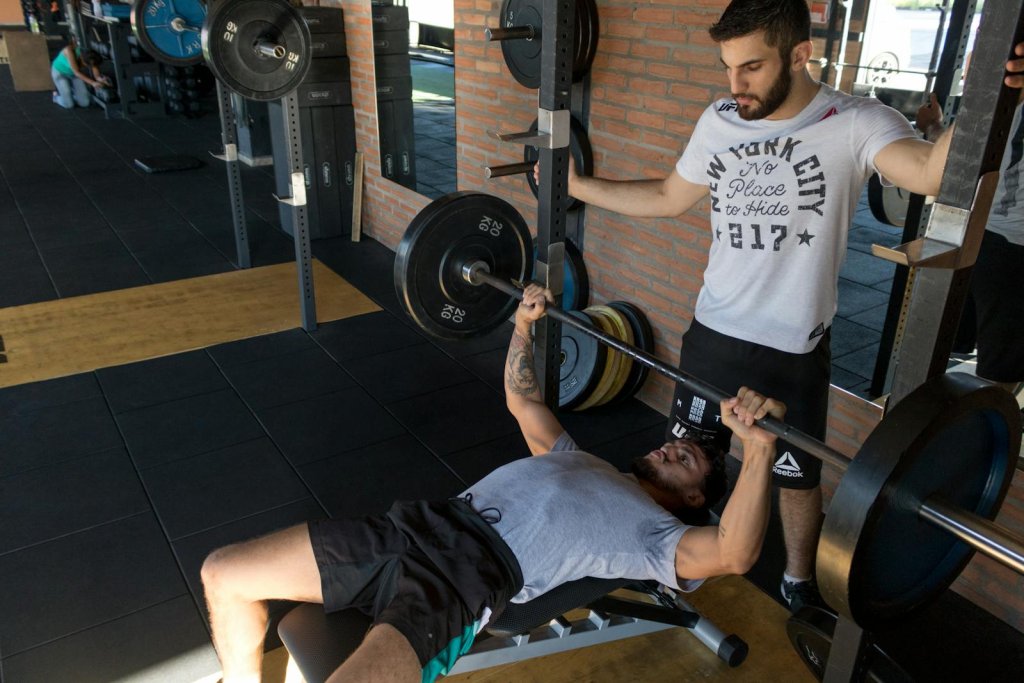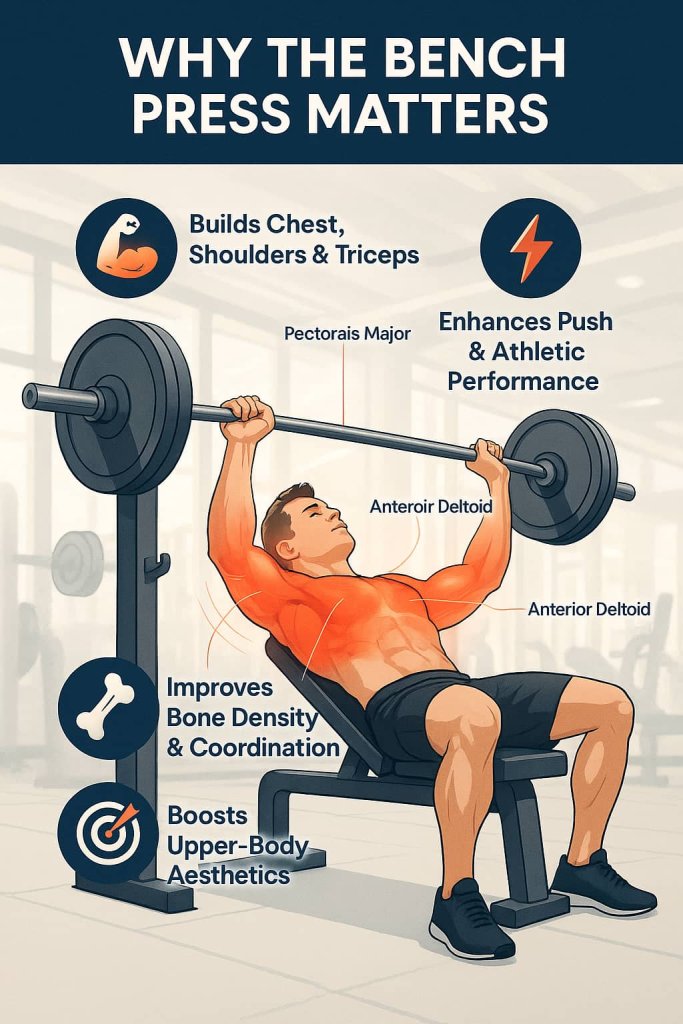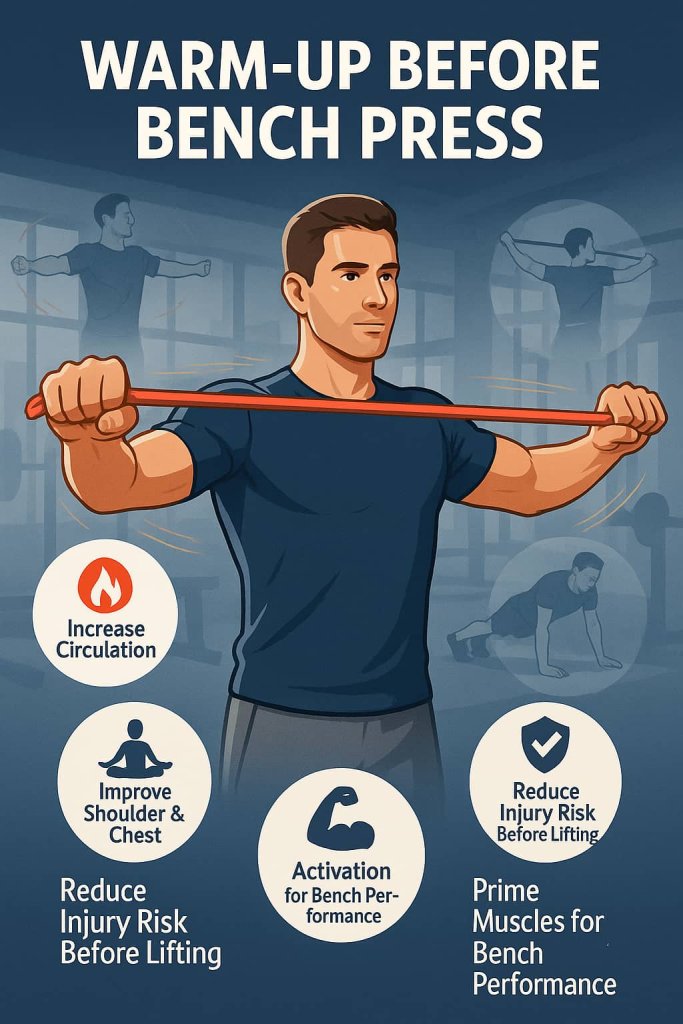The bench press is one of the most powerful exercises for building a bigger, stronger chest.
It engages the pectorals, shoulders, and triceps while developing overall upper-body power. Understanding how to vary your bench press routine can help you avoid plateaus, increase strength, and sculpt a well-balanced chest.

Whether you’re a beginner or advanced lifter, mastering different bench press variations ensures full chest development and strength gains. This guide breaks down 14 of the best bench press workouts — supported by the latest research — to help you build size, definition, and explosive power safely and efficiently.
Why the Bench Press Matters
According to Healthline, the bench press activates multiple upper-body muscles simultaneously, improving strength and muscle symmetry. A PubMed study found that performing bench press through a full range of motion increases neuromuscular activation compared to partial reps — promoting superior strength and hypertrophy.

Key Benefits:
- Builds chest, shoulders, and triceps strength
- Enhances pushing power and athletic performance
- Improves bone density and muscle coordination
- Boosts upper-body aesthetics and confidence
Warm-Up Before Bench Press
Before loading the bar, warm up for 5–10 minutes to improve circulation and joint mobility.

Try:
- Arm circles and band pull-aparts
- Light push-ups or dumbbell presses
- Shoulder dislocates with a resistance band
Trainer Tip: Never skip your warm-up — it primes your joints and prevents injury during heavy sets.
14 Best Bench Press Workouts
Each workout below includes why it works, muscles worked, how to do it, and a trainer tip for perfect execution.
1. Barbell Bench Press (Flat)
Why it works:
The traditional flat barbell bench press is the gold standard for upper-body strength. It recruits the greatest overall muscle mass across the pectoralis major, triceps, and front deltoids, making it ideal for building strength and thickness through the middle chest.
Muscles worked:
Pectoralis major (sternal head), anterior deltoids, triceps brachii, serratus anterior, and stabilizers in the rotator cuff.
How to do it:
- Lie flat on the bench with feet firmly grounded for stability.
- Grip the bar slightly wider than shoulder-width.
- Inhale deeply, engage your core, and unrack the bar.
- Lower slowly to mid-chest, keeping elbows at about a 45° angle.
- Press upward explosively until arms are extended, exhaling on the push.
Trainer Tip:
Keep your shoulder blades retracted and maintain a natural arch in your lower back. Avoid bouncing the bar — control each rep for better muscle activation and joint safety.
2. Incline Barbell Bench Press
Why it works:
The incline bench press shifts load toward the upper chest and shoulders, helping develop a full, balanced chest profile.
Muscles worked:
Upper pectorals, anterior deltoids, triceps, and upper trapezius stabilizers.
How to do it:
- Set your bench to a 30–45° incline.
- Use a medium grip and unrack the bar.
- Lower slowly to the upper chest (just below collarbone level).
- Push upward and slightly backward toward starting position.
Trainer Tip:
Don’t flare your elbows out — keep them angled slightly inward to minimize shoulder stress.
3. Decline Barbell Bench Press
Why it works:
This variation increases emphasis on the lower pectoral region, improving chest fullness and enhancing lockout power. Decline angles reduce shoulder involvement, allowing better chest isolation.
Muscles worked:
Lower pectoralis major, triceps, and anterior deltoids.
How to do it:
- Secure your legs under the decline bench pads.
- Grip the bar slightly wider than shoulder-width.
- Lower the bar to the lower chest, pause briefly, then push up explosively.
Trainer Tip:
Keep your core tight throughout the lift — avoid over-arching or letting hips rise off the bench.
4. Dumbbell Bench Press
Why it works:
Dumbbells allow greater freedom of movement and deeper stretch at the bottom of the rep, which enhances chest activation and symmetry. They also recruit stabilizer muscles for balanced development.
Muscles worked:
Pectoralis major, triceps, deltoids, and rotator cuff stabilizers.
How to do it:
- Lie flat holding dumbbells at chest level, palms forward.
- Lower the weights slowly until elbows reach 90°.
- Press upward and slightly inward, without letting dumbbells touch.
Trainer Tip:
Maintain control at the bottom and top of each rep. Avoid locking elbows fully to keep constant muscle tension.
5. Incline Dumbbell Press
Why it works:
An incline angle increases activation in the upper chest and front shoulders while allowing a longer range of motion than a barbell.
Muscles worked:
Upper pectorals, anterior deltoids, triceps.
How to do it:
- Set your bench to a 30–45° incline.
- Hold dumbbells above shoulders with palms facing forward.
- Lower in a wide arc until elbows are level with your chest.
- Press back up in a smooth, controlled motion.
Trainer Tip:
Keep shoulder blades pinched and avoid raising your head during the press.
6. Close-Grip Bench Press
Why it works:
This triceps-dominant variation improves pressing lockout strength and boosts upper-chest development by reducing shoulder strain.
Muscles worked:
Triceps brachii (long and lateral heads), inner pectorals, and anterior deltoids.
How to do it:
- Grip the bar about shoulder-width apart.
- Lower to your sternum while keeping elbows close to your torso.
- Press straight upward, focusing on triceps engagement.
Trainer Tip:
Avoid an excessively narrow grip — it can stress wrists and elbows.
7. Reverse-Grip Bench Press
Why it works:
Flipping the grip (palms facing you) increases activation of the upper chest while decreasing shoulder stress.
Muscles worked:
Upper pectorals, triceps, front deltoids.
How to do it:
- Use a supinated (underhand) grip, slightly narrower than shoulder-width.
- Lower to mid-chest under control.
- Press up smoothly to full extension.
Trainer Tip:
Always use a spotter for safety — this grip is less stable for heavy loads.
8. Smith Machine Bench Press
Why it works:
The guided motion allows you to isolate chest muscles and reduce the need for stabilizers, great for hypertrophy training.
Muscles worked:
Pectorals, triceps, anterior deltoids.
How to do it:
- Position your bench so the bar aligns with mid-chest.
- Lower bar slowly, pausing at the bottom.
- Press upward through your chest, not shoulders.
Trainer Tip:
Don’t let the machine take over — maintain full control through the entire range.
9. Floor Press
Why it works:
Shortens range of motion, focusing on triceps and mid-range strength while minimizing shoulder stress.
Muscles worked:
Triceps, chest, shoulders.
How to do it:
- Lie flat on the floor beneath a barbell.
- Lower until elbows touch the floor, then press upward.
Trainer Tip:
Perfect for powerlifters aiming to improve lockout performance.
10. Spoto Press
Why it works:
Developed by elite powerlifter Eric Spoto, this movement enhances pause control and explosive power off the chest by pausing just above it.
Muscles worked:
Chest, triceps, anterior deltoids.
How to do it:
- Lower bar to one inch above your chest, hold for a brief pause.
- Explosively press upward without losing tightness.
Trainer Tip:
Stay tight through the core and glutes; do not relax during the pause.
11. Pin Press
Why it works:
Builds starting and mid-range strength by pressing from a dead stop. Great for overcoming sticking points.
Muscles worked:
Triceps, pectorals, shoulders.
How to do it:
- Set safety pins at desired height (about halfway down).
- Start from pins and press up to lockout.
Trainer Tip:
Use moderate to heavy loads but maintain explosive intent every rep.
12. Pause Bench Press
Why it works:
Pausing at the chest removes momentum, increasing time under tension and teaching better control.
Muscles worked:
Chest, triceps, shoulders, and core stabilizers.
How to do it:
- Lower the bar slowly until it touches your chest.
- Pause for 1–2 seconds, keeping muscles tight.
- Drive the bar upward explosively.
Trainer Tip:
Use lighter weights at first — control is more important than load.
13. Resistance Band Bench Press
Why it works:
Adds variable resistance, forcing you to accelerate through the lift and increasing power development.
Muscles worked:
Chest, triceps, deltoids, stabilizers.
How to do it:
- Secure resistance bands to the barbell and bench frame.
- Perform presses as usual, feeling increasing tension at the top.
Trainer Tip:
Keep tempo consistent and use strong, even resistance bands.
14. Dumbbell Floor Press
Why it works:
Removes leg drive and limits shoulder strain while emphasizing triceps and chest control.
Muscles worked:
Triceps, chest.
How to do it:
- Lie on your back holding dumbbells above your chest.
- Lower until elbows gently touch the floor.
- Press upward, keeping forearms vertical.
Trainer Tip:
Avoid resting elbows on the floor between reps — maintain constant tension.
Pro Tips for Better Bench Press Performance
- Train 2–3 times per week: Allow at least 48 hours between sessions for recovery.
- Use progressive overload: Gradually increase weight or reps to stimulate muscle growth.
- Focus on form over ego: Controlled reps prevent injury and build real strength.
- Don’t neglect supporting muscles: Strengthen shoulders, triceps, and back for balanced progress.
Common Bench Press Mistakes to Avoid
- Bouncing the bar off the chest
- Flaring elbows too wide
- Skipping warm-ups
- Neglecting proper spotter or safety setup
- Overtraining without rest
FAQ
1. What is the best bench press angle for upper chest growth?
A 30–45° incline is ideal for upper-chest activation.
2. How often should I bench press per week?
2–3 sessions per week with proper recovery works best for strength and hypertrophy.
3. Should I arch my back during the bench press?
Yes, a natural arch helps maintain shoulder safety and power transfer — not excessive hyperextension.
4. What grip width builds the most muscle?
A medium grip (1.5× shoulder width) provides balanced chest and triceps engagement.
5. Are dumbbells or barbells better for size?
Both work — barbells for strength, dumbbells for muscle balance and range of motion.
6. What’s the safest way to bench press alone?
Use a power rack with safety bars or switch to Smith machine or dumbbells.
7. Should I touch my chest on every rep?
Yes — a full range of motion ensures maximal activation and strength gains.
Conclusion
The bench press remains a cornerstone of upper-body strength and chest development.
By rotating these 14 variations, you’ll stimulate every part of your pecs, improve stability, and build explosive pressing power safely.
Start light, focus on form, and track progress weekly. With consistency and smart programming, you’ll transform your chest and upper-body strength faster than ever.
References
- Full vs. Partial ROM (bench press) – Martínez-Cava et al., 2022, JSCR — Full ROM produced greater neuromuscular adaptations than partial ROM; ideal for your form/safety cues and FAQs.
- Incline angles & EMG (upper-chest emphasis) – Rodríguez-Ridao et al., 2020, Int J Environ Res Public Health (PMC) — ~30° incline increases clavicular pec activation vs. flat/steeper angles.
- Grip width effects (strength & muscle activity) – Saeterbakken et al., 2021, Int J Environ Res Public Health (PMC) — Narrow/medium/wide grips alter 6-RM loads and EMG; informs your grip guidance.
- Pause/Spoto mechanics (control & power) – Pallarés et al., 2014, J Sports Sci — Imposing a pause changes velocity/power characteristics; supports pause bench cues.
- Accommodating resistance vs. constant load (strength/power) – Ataee et al., 2014, Ann Appl Sport Sci (PMC) — Bands/chains can enhance strength and power; great for banded bench rationale.
- Acute performance with accommodating resistance – Masel et al., 2023, Biology (PMC) — Adding bands/chains improves subsequent explosive performance; supports power blocks.
- Training frequency/progression guidelines (YMYL foundation) – ACSM Position Stand, 2009 (PDF) — Authoritative guidance on progression, volume, and frequency; anchors your “Frequency & Recovery” section.
